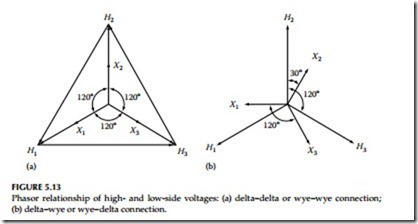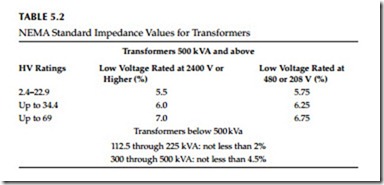Transformer Characteristics
Most transformers used in industrial and commercial facilities range from 500 to 2500 kVA and are three-phase, liquid-filled or dry type located indoors.
(b) delta–wye or wye–delta connection.
These transformers are part of secondary unit substations supplying service to load centers. Transformers used for the distribution of power in plants and buildings have similar characteristics, which have been standardized as follows:
kVA rating: The rating must be adequate to carry the connected load.
Voltage ratings: The voltage rating provides the primary and secondary volt- age to transform electrical energy from primary voltage to secondary voltage. This rating is associated with the winding turns ratios of the primary and secondary windings. Some examples of standard voltage ratings for power transformers are shown in Table 5.1.
Cooling: The type of cooling determines the method of medium used to dissipate heat generated in the transformer. Transformer kVA rating is speci- fied based upon the temperature rise allowed for a given transformer.
Insulation class: The insulation class of a transformer is based upon the nominal voltage levels at which the system voltages and currents are transformed. For example, the ANSI standard C57.12 secondary and primary substation voltage ratings are listed in Table 5.1 for the various insulation-class levels.
Impedance level: The impedance of a transformer can be expressed as an imped- ance drop expressed in percent. This is equal to impedance drop voltage expressed as a percentage of rated terminal voltage. For most power transformers, the imped- ance can be considered equal to the reactance since the resistance component is very small. The NEMA has standardized the impedance values for transformers that are built in accordance with NEMA standards, which are shown in Table 5.2.
Short-circuit conditions: The ANSI standard C57.12 defines the short-circuit withstand capability of a transformer as the ability to withstand without- injury short circuits on any external terminals, with rated line voltages
maintained on all terminals intended for connection to sources of power. The duration and values of short circuit are limited by ANSI as follows:
Voltage taps: Many power transformers for industrial applications are equipped with voltage ratio tap changers. The tap changer is used to main- tain a constant secondary voltage with variable primary voltage or to control the secondary voltage with a fixed primary voltage. Usually, most transform- ers will have two 5% taps or four 2.5% taps on the HV side for adjustment to maintain constant secondary voltage.
Sound level: All transformers hum and create noise when they are ener- gized. This noise is generated by vibrations in the laminated core, and the
noise frequency is double the fundamental frequency. The noise level of transformers should be considered during installation in order not to exceed Occupational Safety and Health Administration (OSHA) regulations. Typical ratings for distribution transformers are listed as follows:
Basic impulse insulation level (BIL): BIL is the crest value of the impulse voltage that the transformer is required to withstand without failure. The transformer BIL impulse duration is 1.2 × 50 μs. That is, the impulse reaches its peak value in 1.2 μs and then decays to 50% of its peak value in 50 μs.
In addition to full BIL value, transformers are tested for chopped-wave with-stand (115% of BIL) and front-of-the-wave withstand (160% of BIL). These tests are intended to simulate conditions that can occur when transformers are subjected to lightning surges.



